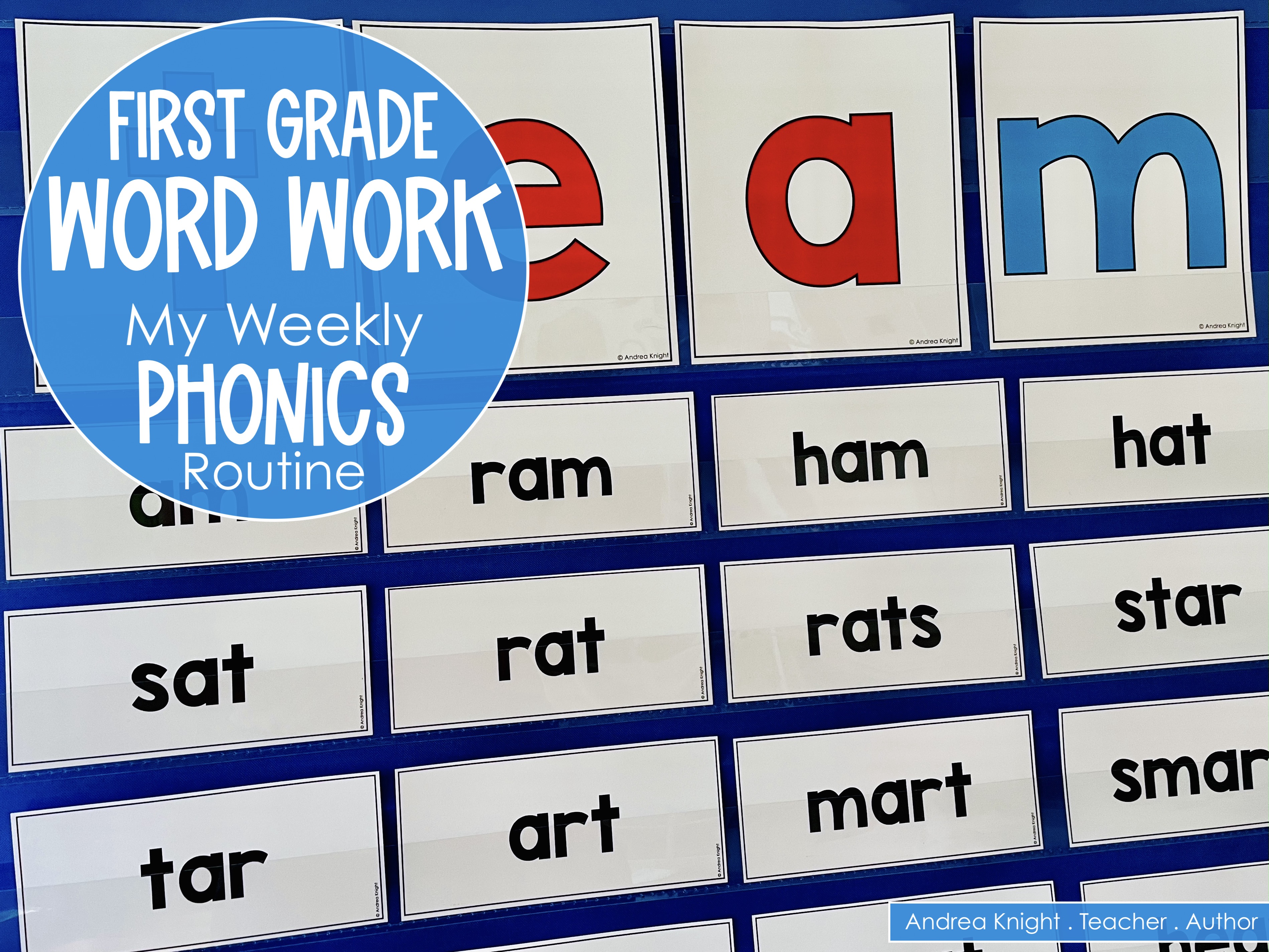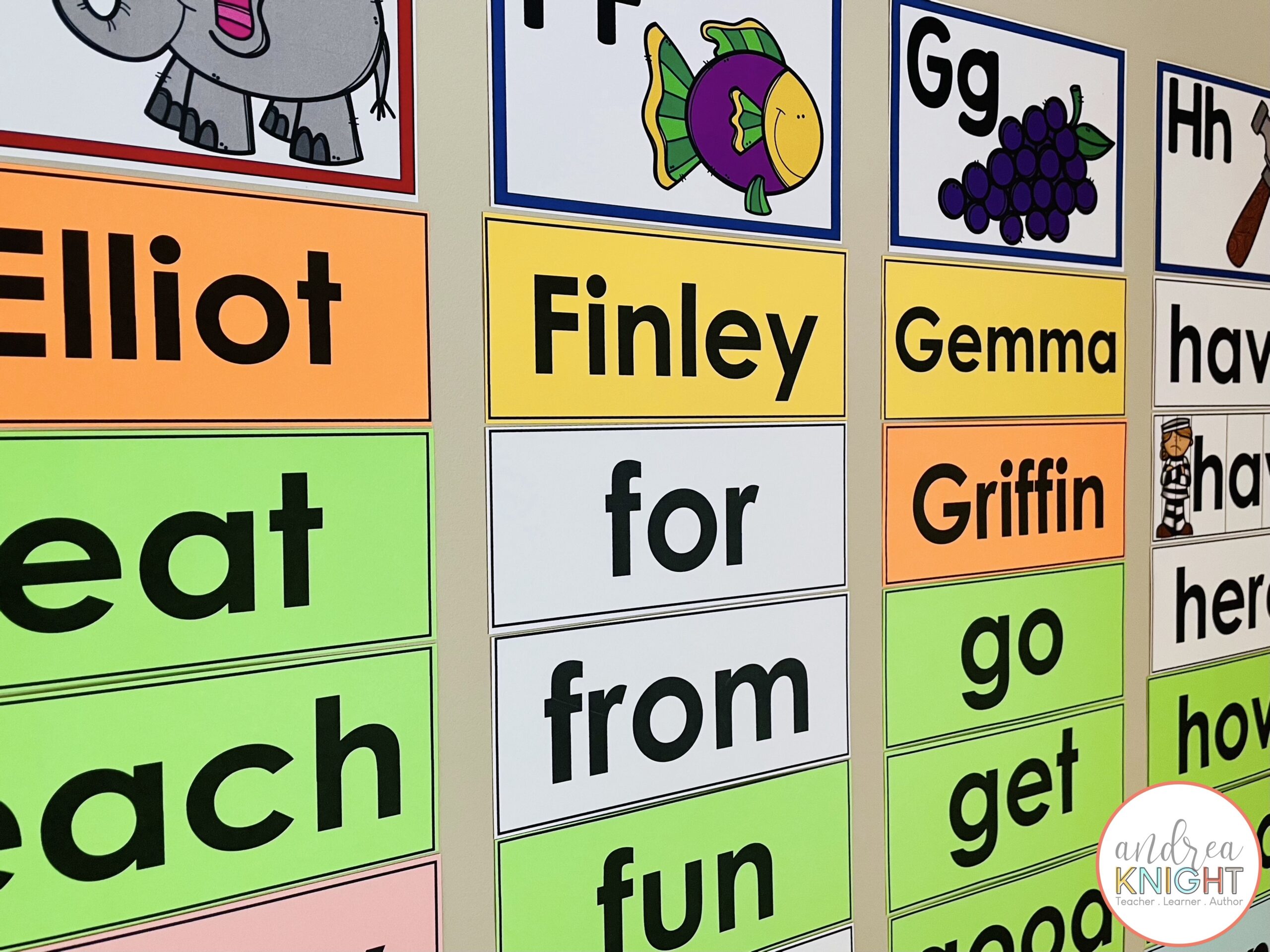
Word work for first grade kids should be fun and engaging. I used to think this also meant wacky and spontaneous, but I quickly learned children thrive within routines. Having predictable schedules and systems doesn’t mean you have to sacrifice fun. In fact, most kids are more eager and receptive when they know what to expect. Wondering what’s going to happen each day leaves many children feeling uneasy … me too, frankly. Routines make room for confidence building. When kids are socially and emotionally prepared by predictable ways of work, they are more likely to build on that familiarity and take risks. The takeaway? Routines aren’t boring. They’re brilliant.
Designing Word Work for First Grade
When I’m planning word work for first grade children, I think first about the routine and the components I want to include. I’ll make small changes within the routine as the kids grow and require more challenging work, but the weekly schedule will be consistent for long periods of time.
Embedded in the weekly work, I make sure I’m providing a variety of activities that will appeal to multiple learning styles. With that in mind, I try to strike a balance between solo work, partner work, and team work. I also integrate music and movement through phonics songs (our favorites are from Jack Harmann on YouTube) and kinesthetic activities like BUMP Games. Modeling and direct instruction are an important part of my lessons, but we also leave plenty of time to apply strategies and play fun games throughout the week.
The Star of the Show
Almost everything we do in terms of word work helps us build and use our word wall. It’s our number one, go-to resource for learning words and becoming independent spellers. For example, every Monday morning, I introduce five new word wall words as part of our phonics routine. (I’ll go into detail about that lesson in a moment.) And on Friday afternoons, I post the new words to the wall. This is how we grow our word wall over the year and these are the words we use for most of our word work games.
I mention this because the word wall is the epicenter of our word work routine. Most of our phonics lessons lead to or from the word wall.
Our Weekly Phonics Routine
- On MONDAYS, I introduce five new word wall words. Of the five, 3-4 are typically words that have a predictable spelling pattern such as -ad, -ast, -out, and -ill. The remaining words are sight words. The words with predictable spelling patterns (or rimes) are the heart of our word wall. These are words that can be used to read and write other words with the same rime. Because sight words are more challenging, I limit those to only 1-2 per week. To make the leap from phonemic awareness to phonics, I use a modified version of Elkonin Boxes, or sound boxes. As I say each new word, we count the sounds we hear, talk about the letters that could make those sounds, and then write the full word. This models the kind of thinking I want them to do when they’re trying to spell unknown words on their own: How many sounds do I hear? What are the sounds I hear? What letters could make those sounds? When we’re finished, we write them playfully on the back of the sheet. If time permits, work in a Jack Hartmann song about counting sounds or building words. We always sing … did I mention that?


The Power of Onsets and Rimes
- On TUESDAYS, we work on writing rhyming words for our new words that aren’t sight words. When you’re planning word work for first grade children, model how knowing one spelling pattern or rime can help them write several other words that rhyme with that word. Knowing this strategy and applying it to their own reading and writing can help them learn so many related words. This is the kind of self-talk I want the children to be doing throughout the day, especially during writing workshop. Begin with a song about rhyming words (again, Jack Hartmann has several) and then work on creating rhyming words. I model writing the words on a chart while the kids record the rhyming words on their own sheet. At the end of that activity, we always play a word wall game, such as word wall laser tag. Planning for games is important because I want to make sure the kids are continually interacting with ALL the words we’re learning.

Differentiated Word Work for First Grade
- On WEDNESDAYS, we do a Making Words lesson. This is the one day of the week that isn’t specific to our new words or our word wall, but it’s work that aligns with those same metacognitive strategies. During a making words lesson, we take what we know about letters, sounds, patterns, and syllables to build a wide variety of words … everything about it is differentiated and it works for everyone, from the developing reader who is excited to build the word at to the more proficient reader who studied different combinations of letters to build the full word hamster. The lesson culminates in a sorting activity so kids can see how sets of words have similar features. You can grab this free lesson👉 HERE. It includes everything you need, including directions, letter cards, word cards, student letter tiles, a list template, and a sorting sheet.
Connecting Our Word Work to Comprehension
- Our word work on THURSDAYS is all about the idea that reading must make sense. Although I’m constantly prompting Does it look right? Does it sound right? and Does it make sense?, I use this day to make connections from our phonics instruction to overall reading comprehension. Jack Hartmann has fun songs about reading comprehension (can you tell he’s married to a primary teacher?), so of course we sing first. Then we practice putting our five new words into cloze sentences. Back in the day, I used to write these on sentence strips, but now I prepare them digitally … it’s easier and everyone can see them better that way. As we figure out which word fits into each sentence, the children record the full sentence on their own paper. This gives me the chance to also reinforce word spacing, capital letters, and punctuation. We end Thursday’s word work with a word wall game, typically Guess My Word. In this game, I provide 5 clues with increasing specificity until the children can guess my secret word. Most children know the word by the final clue, and it gives them repeated exposure to the word wall words.

Spelling Assessments
- On FRIDAYS, I plan for a spelling assessment. I’m often asked about spelling tests when I’m in conversations about word work for first grade children. Although I’m not necessarily a fan of traditional spelling tests, I do value the information I get from a well-intentioned assessment. I’m not a teacher who tries to trick kids and I don’t use assessments to “catch” them. Evaluations of any kind should be used to assess development, identify strengths and needs, and guide future instruction. It shouldn’t feel punitive or, in my opinion, be publicly displayed. There are definitely benefits to showing children how to privately collect their own data and set personal goals, but displaying student progress (or lack thereof) can be humiliating. At the beginning of the year, I want children to feel confident and experience success right away, so I use an assessment template designed with those outcomes in mind. See the samples below.👇

- Once we’ve been in school for about 2-4 weeks, I move into more of a traditional look where kids spell the words on their own. It’s important to me that they know how to spell the new words we’ve been practicing all week, but equally important, I want to know if they can use the spelling patterns in their new words to write words that rhyme with them. For example, I might say: “Number one, spell our new word jump. Number two, use the pattern in jump to spell the word bump.” I also add scrambled word wall words to the bottom of the page so the kids can continue to interact with old words. I don’t know what it is, but they LOVE to unscramble!
Want More Ideas?
If you’d like to read a little more about how I use the word wall in our phonics routine, check out this blog post: First Grade Word Walls Kids Will Use.
My students also love Mirror, Mirror on the Wall, a word wall game where they hunt for words I’ve typed backwards and read them using a mirror. Similarly, we have cards where I’ve typed word wall words in very small font, requiring a magnifying glass to read them. The Internet is loaded with fun games for practicing words. Find ones you love and work them into your weekly routine.
If you have ideas about word work for first grade … maybe something you do in your classroom that your students love … feel free to leave a comment below👇. I’d love to know what works for others!
Until then, happy teaching!


